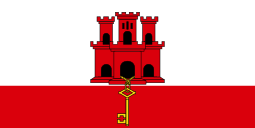Edward Cornwallis
| Edward Cornwallis | |
|---|---|
 Edward Cornwallis by Joshua Reynolds (1756) | |
| Born |
5 March 1713 London, England |
| Died |
14 January 1776 (aged 62) Gibraltar |
| Buried at | Culford, Suffolk |
| Allegiance |
|
| Service/branch | British Army |
| Years of service | 1730s-1776 |
| Rank | Lieutenant General |
| Unit | 8th Foot |
| Commands held | 20th Foot, 40th Foot, 24th Foot |
| Battles/wars | |
| Relations |
Charles Cornwallis, 4th Baron Cornwallis – father Lady Charlotte Butler – mother Mary Townshend – wife |
| Other work | Governor of Gibraltar |
Lieutenant General Edward Cornwallis (5 March 1713 – 14 January 1776) was a British military officer who was the first Governor of Nova Scotia at Halifax, Nova Scotia. He later served as the Governor of Gibraltar.[1]
Early life
He was the sixth son of Charles, 4th Baron Cornwallis, and Lady Charlotte Butler, daughter of the Earl of Arran.[2] The Cornwallis family possessed estates at Culford in Suffolk and the Channel Islands.[2] His grandfather, Charles Cornwallis, 3rd Baron Cornwallis, was First Lord of the Admiralty. His nephews were Charles Cornwallis, 1st Marquess Cornwallis, James Cornwallis, 4th Earl Cornwallis, and William Cornwallis.
He and his twin brother, Frederick Cornwallis, were made royal pages at the age of 12.[2] They were enrolled at Eton at age 14. Their brother, Stephen Cornwallis, rose to the rank of General in the Army.
It was initially unclear which brother would enter the church and which the military. The matter was decided when, one day, Frederick fell and paralyzed his arm; he would take the religious path.[3]
At age 18, Edward was commissioned into the 47th Regiment of Foot in 1731.[2]
Military career
War of the Austrian Succession
Cornwallis participated in the Battle of Fontenoy during the War of the Austrian Succession. He fought under Colonel Craig, who was killed in action. Cornwallis took over command of the regiment and organized a retreat. Cornwallis's regiment lost eight officers and 385 men. While the retreat was respected by the military, the British public mocked Cornwallis and the other leaders.[4]
Cornwallis played an important role in suppressing the Jacobite rising of 1745.[2] He fought for the victorious British soldiers at the Battle of Culloden and then led a regiment of 320 men north for the Pacification of the Scottish Highlands. The Duke of Cumberland ordered him to "plunder, burn and destroy through all the west part of Invernesshire called Lochaber." Cumberland added: "You have positive orders to bring no more prisoners to the camp."[5] Cornwallis's campaign was later described as one of unrestrained violence.[6] Cornwallis ordered his men to chase off livestock, destroy crops and food stores.[7] Cornwallis's soldiers used rape and mass murder to intimidate Jacobites from further rebellion.[8]
In 1747 he was made a Groom of the Bedchamber serving in the households of both George II and George III until 1764.
Founding of Halifax
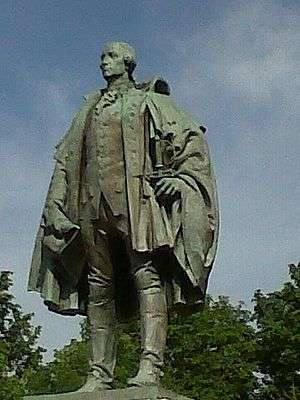
The British Government appointed Cornwallis as Governor of Nova Scotia with the task of establishing a new British settlement to counter France's Fortress Louisbourg. He sailed from England aboard HMS Sphinx of 14 May 1749, followed by a settlement expedition of 15 vessels and about 2500 settlers. Cornwallis arrived at Chebucto Harbour on 21 June 1749, followed by the rest of the fleet five days later. There was only one death during the passage due to careful preparations, good ventilation and good luck, a remarkable feat when Transatlantic expeditions regularly lost large numbers to disease.[9]
Cornwallis was immediately faced with a difficult decision: where to site the town. Settlement organizers in England had recommended Point Pleasant due to its close access to the ocean and ease of defence. His naval advisers opposed the Point Pleasant site due to its lack of shelter and shallows which would not allow ocean-going ships to dock. They wanted the town located at the head of Bedford Basin, a sheltered location with deep water. Others favoured Dartmouth. Cornwallis made the decision to land the settlers and build the town at the site of present-day Downtown Halifax halfway up the harbour with deep water, protected by a defensible hill (later known as Citadel Hill). By 24 July, the plans of the town had been drawn up and on 20 August lots were drawn to award settlers their town plots in a settlement that was to be named "Halifax" after Lord Halifax the President of the Board of Trade and Plantations who had drawn up the expedition plans for the British Government.[10]
Relations with the Wabanaki Confederacy
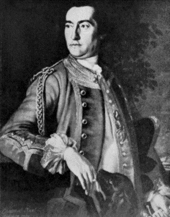
One of Cornwallis' first priorities was to make peace with the Wabanaki Confederacy, which included the Mi'kmaq. (The Confederacy had been aligned with New France through four wars starting with King William's War.) A group of Maliseet, Passamaquoddy and single band of Mi'kmaq met with Cornwallis in the Summer of 1749. They agreed with the British to end fighting and renewed an earlier treaty drafted in Boston, redrafted as the Treaty of 1749.[11]
However Cornwallis's diplomatic efforts were doomed to failure. The treaties signed at Halifax represented mostly native groups in New Brunswick. Most Mi'kmaq leaders in Nova Scotia regarded the unilateral establishment of Halifax as a violation of an earlier treaty with the Mi'kmaq people (1726), signed after Father Rale's War.[12] Mi'kmaq leaders met at St. Peters in Cape Breton in September 1749 to respond to British moves. They composed a letter to Cornwallis making it clear that, while they tolerated the small garrison at Annapolis Royal, they completely opposed settlement at Halifax: "The place where you are, where you are building dwellings, where you are now building a fort, where you want, as it were, to enthrone yourself, this land of which you want to make yourself absolute master, this land belongs to me". Cornwallis had no authority to respond by abandoning the Halifax expedition and Mi'kmaq leaders regarded the Halifax settlement as "a great theft that you have perpetrated against me."[13]
A wave of Mi'kmaq attacks began immediately after the letter. At Chignecto Bay, two British ships were attacked while two others were seized at Canso. At Halifax, attacks began on settlers and soldiers outside the fortified township, beginning with the first of several raids on the longhouse settlement at Dartmouth across the harbour. This stage of the long-running Anglo-Mi'kmaq conflict is known by some historians as Father Le Loutre's War.
Father Le Loutre's War
Cornwallis sought to project British military forces by establishing forts in the largest Acadian communities, which were located at Windsor (Fort Edward), Grand Pre (Fort Vieux Logis) and Chignecto (Fort Lawrence). As a result, during Cornwallis's three years in Nova Scotia, Acadians and Mi'kmaq people orchestrated attacks on the British at Chignecto, Grand Pre, Dartmouth, Canso, and Halifax. The French erected forts at present day Saint John, Chignecto and Port Elgin, New Brunswick. Cornwallis's forces responded by attacking the Mi'kmaq and Acadians at Mirligueche (later known as Lunenburg), Chignecto and St. Croix.
To stop the Mi'kmaq attacks on the British settlers, Cornwallis issued a proclamation to separate the two populations. Cornwallis proclamation banned the Mi'kmaq from peninsular Nova Scotia. Within this proclamation was a bounty put on Mi'kmaw fighters to kill or capture them. By the time Cornwallis had arrived in Halifax, there was a long history of the Wabanaki Confederacy (which included the Mi'kmaq) protecting their land by killing British civilians along the New England/ Acadia border in Maine (See the Northeast Coast Campaigns 1688, 1703, 1723, 1724, 1745, 1746, 1747).[12][14]
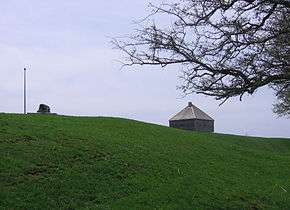
There was also a long history of British governors making proclamations against the Mi'kmaq for their raids on British settlements.[15] Cornwallis followed New England's example when, after the Raid on Dartmouth (1749), he created a banishment proclamation that put a bounty on Mi'kmaq men, offering money to kill or take them prisoner (1749). Unlike other Governors before and after him, however, Cornwallis did not target women and children.[16]
In Acadia and Nova Scotia, both the British and Wabanaki Confederacy engaged in frontier warfare. While the British paid the New England Rangers for Mi'kmaq scalps, the French paid members of the Wabanaki Confederacy for British scalps.[Note 1] At the same time the British were adopting an uncomplicated, racially based view of local politics, several leaders of the Mi'kmaq community were developing a similar stance.[18] According to historian Geoffery Plank, both combatants understood their conflict as a "race war", and both the Mi’kmaq and British were "single-mindedly" determined to drive each other from the peninsula of Nova Scotia.[19] The bounties were not effective. Cornwallis was forced to dramatically increase what he was willing to pay for a scalp in March 1751. This increase only resulted in one scalp being collected within the following four months.[20]
After eighteen months of inconclusive fighting since the outbreak of the war, uncertainties and second thoughts began to disturb both the Mi’kmaq and the British communities. By the summer of 1751 Governor Cornwallis began a more conciliatory policy. For more than a year, Cornwallis sought out Mi’kmaq leaders willing to negotiate a peace. On 16 February 1752, hoping to lay the groundwork for a peace treaty, he repealed his 1749 proclamation against the Wabanaki Confederacy.[21] Having only committed to being Governor for two years, Cornwallis eventually resigned his commission and left the colony in October 1752.[19][22] Cornwallis laid the groundwork for the peace treaty signed shortly after he left. Chief Jean-Baptiste Cope signed the only peace treaty of the war, which was ultimately rejected by most of the other Mi'kmaq leaders. Cope burned the treaty six months after he signed it.)[23]
Cornwallis left Nova Scotia in 1752, three years before Father Le Loutre's War ended in 1755, and was appointed Colonel of the 24th Regiment of Foot.
Seven Years War
In November 1756 Cornwallis was one of three colonels who were ordered to proceed to Gibraltar and from there embark for Minorca, which was then under siege from the French.[2] Admiral John Byng called a council of war, which involved Cornwallis, and advised the return of the fleet to Gibraltar leaving the garrison at Minorca to its fate.[2] Byng, Cornwallis and the other officers were arrested when they returned to England. A large, unruly mob attacked the officers as they left their ships in Portsmouth and later burned effigies of Cornwallis and the other officers.[24]
The officers faced court martial on "suspicion of disobedience of orders and neglect of duty."[25] Byng was found guilty and executed. Cornwallis testified that he had not disobeyed orders, but that it was "impracticable" to land at Minorca due to stiff French defences. Further, he said he was following Byng's command. "I looked upon myself as under the command of the admiral and should have thought it my duty to have obeyed him," he testified.[25] Cornwallis was judged to have been a passenger under the control of Byng and was thus exonerated.
Cornwallis was also one of the senior officers in the September 1757 Raid on Rochefort which saw a failed amphibious descent on the French coastline.[2] The vast force massed on the Isle of Wight before sailing for Rochefort. The fleet stopped at Ile D'Aix and examined the French defences. General Sir John Mordaunt, head of the land forces, decided the defences were too strong to attack. He called a council of war. Cornwallis voted to retreat, while Admiral Edward Hawke, head of the naval forces, and James Wolfe, quartermaster general, voted to attack. Mordaunt and Cornwallis carried the day and the mission was abandoned.[26]
Mordaunt was arrested and faced court martial. Cornwallis testified that an attempted landing at Rochefort would have been "dangerous, almost impracticable and madness."[27] Mordaunt was found not guilty, but the court martial left a stain on his career, and the career of Cornwallis.[28]
Governor of Gibraltar
Cornwallis served as the Governor of Gibraltar from 14 June 1761 to January 1776 when he died at the age of 63.[2]
His body was returned to England and laid to rest at Culford Parish Church in Culford, near Bury St. Edmunds on 9 February 1776.
Personal life

In 1763, Cornwallis married Mary Townshend, daughter of Charles Townshend, 2nd Viscount Townshend and Dorothy Townshend (Walpole). His marriage to Mary did not produce any children. His brother, Charles Cornwallis, 1st Earl Cornwallis married Mary's half sister, Elizabeth, daughter of Charles and his first wife, Elizabeth Pelham. Through his brother's marriage, he became uncle of General Lord Cornwallis.[29]?
Legacy
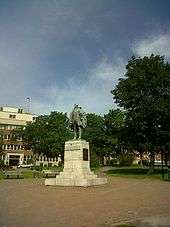
Several buildings (Canadian Forces Base Cornwallis, a former Canadian Forces Base located in Deep Brook, Nova Scotia), places (Cornwallis Street in Halifax, Cornwallis Street in Shelburne, the Cornwallis River, and Cornwallis Park, Nova Scotia) and other landmarks have been named in honour of Cornwallis's legacy. A number of ships were named after Cornwallis, including the 1944 harbour ferry Governor Cornwallis and the Canadian Coast Guard Ship Edward Cornwallis. The Edward Cornwallis Statue was erected in 1931 by J. Massey Rhind, an associate of the Royal Scottish Academy. The statue stands at the center of Cornwallis Park in downtown Halifax.
The appropriateness of prominent memorials to Cornwallis has been controversial; it has been argued that—despite his significance to provincial history—that Cornwallis should not be given such prominent recognition due to his actions against Mi'kmaq civilians. A notable critic against such tributes is Daniel N. Paul, a Mi'kmaq historian; Paul argued that Cornwallis' scalping proclamation was not as widely discussed as it is in the present day, and that the increased availability of information regarding Cornwallis' actions—which he regards as genocide, although this claim has been disputed by other historians—had tarnished his reputation.[30][31]
Paul has frequently campaigned for the renaming of buildings and streets bearing the name of Cornwallis; he was credited with influencing the 1995 renaming of Halifax's Cornwallis Place to Summit Place (in honour of the 21st G7 summit).[31][32][33] In June 2011, acting upon a motion by its Mi'kmaq representative Kirk Arsenault, the Halifax Regional School Board voted to rename the Cornwallis Junior High School to remove Cornwallis's name: Arsenault stated in the motion that its naming was "deeply offensive to members of our Mi'kmaq communities and to Nova Scotians generally who believe school names should recognize persons whose contributions to society are unblemished by acts repugnant to the values we wish our schools to embody and represent."[34]
The debate over the Cornwallis statue resurfaced in December 2015, when Premier of Nova Scotia Stephen McNeil—after the removal of a sign near marking the Cornwallis River near a Mi'kmaq community for sensitivity reasons—stated that he planned to request its removal from Cornwallis Park, going on to say that "he is part of the history of this area, bad or good, he's still part of it. He should be acknowledged for that part. But it should also be taught some of the atrocities that he committed." Halifax council member David Hendsbee proposed a compromise of moving the statue to the downtown riverfront, facing the Halifax Citadel as a nod to where he first arrived. In May 2016, a motion was made in Halifax Regional Council to rename municipal properties bearing Cornwallis's name, but it was defeated 8-7.[35][36]
In popular culture
- Edward Cornwallis is the subject of The Hampton Grease Band song entitled "Halifax" which appears on the double album Music to Eat.
See also
- Military history of Nova Scotia
- Military history of the Mi’kmaq People
- Military history of the Acadians
Notes
References
- ↑ Gray (2004)
- 1 2 3 4 5 6 7 8 9 Mastermason.com profile of Edward Cornwallis
- ↑ Tattrie (2013), p. 36
- ↑ Tattrie (2013), p. 20
- ↑ Tattrie (2013), p. 28
- ↑ Plank (2005), p. 67
- ↑ Tattrie (2013), p. 29
- ↑ Tattrie (2013), p. 31
- ↑ Raddall (1948), pp. 24–25
- ↑ Beck, J. Murray (1979). "Cornwallis, Edward". In Halpenny, Francess G. Dictionary of Canadian Biography. IV (1771–1800) (online ed.). University of Toronto Press.
- ↑ Patterson (1994), p. 129
- 1 2 Grenier (2008)
- ↑ Johnston (2008), pp. 38–40
- ↑ Reid (2008)
- ↑ Drake (1870), p. 134
- ↑ The proclamation simple mentions killing or capturing Mi'kmaq - it does not specify women and children. Since he only offered one set price per scalp, he would have only paying for Mi'kmaq fighters. If he was targeting women and children he would indicated a different amount that was much less, as was the custom of Governors before and after him.
- ↑ See Grenier (2008), p. 152 and Faragher (2005), p. 405.
- ↑ Plank (1996), p. 33
- 1 2 Plank (1996), p. 34
- ↑ London Magazine. Vol. 20. 1751. p. 341
- ↑ Patterson (1994), p. 134
- ↑ William Shirley Correspondence, p. 503
- ↑ Plank (1996), pp. 33–34
- ↑ Tattrie (2013), p. 212
- 1 2 The Report of the General Officers, Appointed to enquire into the conduct of Major General Stuart, and Colonels Cornwallis and the Earl of Effingham, Dec. 8, 1756.
- ↑ Tattrie (2013), pp. 217–220
- ↑ The Proceedings of a General Court-Martial held at Whitehall upon the Trial of Lieutenant-General Sit John Mordaunt.
- ↑ Tattrie (2013), p. 220
- ↑ http://www.thepeerage.com/p19820.htm#i198192
- ↑ "Historian's Mi'kmaq genocide claim challenged". CBC News. Retrieved 12 May 2016.
- 1 2 "Cornwallis foes will win eventually, says Mi'kmaq historian". Local Xpress. Retrieved 12 May 2016.
- ↑ "Cornwallis Park should be renamed, say Halifax protestors". CBC News. 29 May 2014. Retrieved 6 May 2016.
- ↑ Bresge, Adina (5 May 2016). "Halifax to consider scrubbing city of Edward Cornwallis". CBC News. Retrieved 6 May 2016.
- ↑ "Cornwallis Junior High to be renamed". The Chronicle-Herald. Archived from the original on June 24, 2011. Retrieved 12 May 2016.
- ↑ "Edward Cornwallis statue should be 'prominently displayed,' Hendsbee says". CBC News. Retrieved 12 May 2016.
- ↑ "Cornwallis statue removal from park should be considered, says premier". CBC News. Retrieved 12 May 2016.
Bibliography
- Drake, Samuel Gardner (1870). A Particular History of the Five Years French and Indian War in New England and Parts Adjacent. With William Shirley. Albany, NY: Joe Munsell.
- Faragher, John Mack (2005). A Great and Noble Scheme: The Tragic Story of the Expulsion of the French Acadians from Their American Homeland. W. W. Norton. ISBN 9780393051353.
- Gray, Charlotte (2004). The Museum Called Canada: 25 Rooms of Wonder. Random House. ISBN 9780679312208.
- Grenier, John (2008). The Far Reaches of Empire: War in Nova Scotia, 1710–1760. Oklahoma University Press.
- Grenier, John (2005). The first way of war: American war making on the frontier, 1607–1814. Cambridge University Press.
- Johnston, A. J. B. (2008). Endgame 1758: The Promise, the Glory, and the Despair of Louisbourg's Last Decade. University of Nebraska Press. ISBN 9780803260092.
- Patterson, Stephen (1994). "1744–1763: Colonial Wars and Aboriginal Peoples". In Phillip A. Buckner & John G. Reid. The Atlantic Region to Confederation. University of Toronto Press. pp. 125–155. ISBN 9780802069771.
- Plank, Geoffrey (1996). "The two Majors Cope: the boundaries of nationality in mid-18th century Nova Scotia". Acadiensis. XXV (2): 18–40.
- Plank, Geoffrey (2001). An Unsettled Conquest: The British Campaign Against the Peoples of Acadia. University of Pennsylvania Press. ISBN 9780812235715.
- Plank, Geoffrey (2005). "New England soldiers in the Saint John River valley: 1758–1760". In Stephen J. Hornsby & John G. Reid. New England and the Maritime Provinces: Connections and Comparisons. McGill-Queen's University Press. pp. 59–73. ISBN 9780773528659.
- Raddall, Thomas Head (1948). Halifax: Warden of the North. McClelland & Stewart.
- Reid, John G. (2008). "Amerindian power in the early modern Northeast: a reappraisal". Essays on Northeastern North America: Seventeenth and Eighteenth Centuries. Toronto: University of Toronto Press. ISBN 9780802091376.
- Tattrie, Jon (2013). Cornwallis: The Violent Birth of Halifax. Pottersfield Press. ISBN 9781897426487.
External links
- Documentary on Cornwallis Statue - CBC Radio - Maritime Magazine Archives
- Centre Acadien (1996)
- Cornwallis - Founder of Freemasonry in Halifax
| Parliament of Great Britain | ||
|---|---|---|
| Preceded by Stephen Cornwallis John Cornwallis |
Member of Parliament for Eye 1743–1749 With: John Cornwallis 1743–1747 Roger Townshend 1747–1748 Nicholas Hardinge 1748–1749 |
Succeeded by Nicholas Hardinge Courthorpe Clayton |
| Preceded by Viscount Trentham Sir Peter Warren |
Member of Parliament for Westminster 1753–1762 With: Viscount Trentham 1753–1754 Sir John Crosse 1754–1761 Viscount Pulteney 1761–1762 |
Succeeded by Viscount Pulteney Hon. Edwin Sandys |
| Military offices | ||
| Preceded by Richard Philipps |
Colonel of the 40th Regiment of Foot 1750–1752 |
Succeeded by Peregrine Hopson |
| Preceded by The Marquess of Lothian |
Colonel of the 24th Regiment of Foot 1752–1776 |
Succeeded by William Taylor |
| Preceded by The Earl of Home |
Governor of Gibraltar 1761–1776 |
Succeeded by Sir John Irwin |

